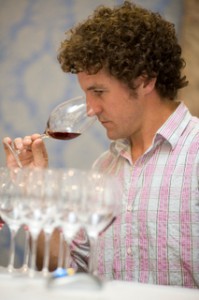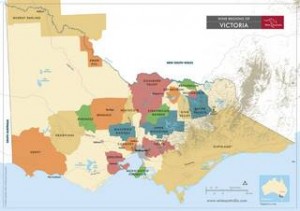Where next for Aussie pinot noir?

Mac Forbes
Australian pinot noir has evolved beyond recognition in the last five to ten years. Cooler sites are being exploited and greater varietal definition and purity are emerging as a result of this, and producers’ growing expertise at managing the fruit/acid paradigm of balance rather than the more typical, for red wine, fruit/tannin paradigm. Inevitably this means a lower perception, and reality, of new oak influence on the fruit from this delicate grape variety. And cooler sites do their part to help preserve more natural acidity in the fruit.
The regions of Australia currently producing some of the best expressions of pinot noir include Tasmania, plus Gippsland, Mornington Peninsula and the Yarra Valley, all in Victoria.
Mac Forbes of Mac Forbes Wines, in the Yarra Valley, led a blind-tasting seminar, in London this month, of Australian pinot noir from these regions. He said: “It’s terrific when there’s excitement in the local industry. From producers’ perspectives, we’re in the midst of an exciting time in history, certainly from a cool climate perspective.”
He emphasised that the Aussies are at the beginning of their learning curve for pinot noir, saying “the questions are far bigger than the answers. We’re asking questions on soils and clones and canopy management. And we’re coming to grips with our own frontier. I’ve never seen so much energy and focus with varieties like pinot noir, as well as pushing the boundaries with other varieties such as shiraz. We’re making a lot of trials, and having a lot of failures.” Not to mention some enormous and encouraging successes to build on.
Another reason for pinot noir being at the beginning of the curve in Australia is that much of the existing planting material was planted in the wrong (warmer) place, with many of the wrong clones. And said Forbes: “a big chunk of pinot noir problems in the past is because they were situated in places where the night time temperatures are too warm. So there’s a loss of aromatics.” In fact, Forbes reckons “the picking date is the most important thing. The acid is dropping, fruit vitality is dropping, so we have a pretty small window to pick. We’re dealing with some fundamental differences in fruit behaviour compared to Europe.” This from a chap who also works in Austria, so he’s able to make direct comparisons with authority.

Victoria
Part of the ongoing challenge is for Australia to identify a style of pinot noir it can claim as its own. New Zealand’s Central Otago has done a fantastic job in this regard. But Australia is so big it’s not going to have just one style. Already Mornington Peninsula is talking about sub-regional styles, and Forbes is pushing Yarra Valley the same way.
For the time being, it’ll be a good job for Australia just to be recognised for producing some proper pinot noir.
Tasting notes
All the wines were from the 2008 vintage, some of which had not yet been released onto the market at the time of tasting. They would be expected to put on a bit of weight, and fatness, in bottle (a good thing in this context)!
Ten Minutes By Tractor, McCutcheon Vineyard Pinot Noir 2008, Mornington Peninsula
15 months in oak, 27% new.
Pale ruby garnet. Aromatic strawberry, heady perfume. Fresh, light elegant attack with piquancy of alcohol (13.8%) in mid palate, bit of dark plum mid palate. Could have a bit more mid-palate density, but very good varietal definition. Hint of the savoury, with long finish.
Kooyong Haven Pinot Noir 2008, Mornington Peninsula
18 months in oak, 30% new.
Medium deep ruby. Rich blueberry aroma, sandalwood spice of new oak peeking through the aroma, not obtrusive. Medium full body, lush sweet fruit (in a dry wine), good slug of slippery glycerol adding to palate texture, fruit slightly hollow mid-palate, and finish a little disappointing on first tasting, but fills out a bit in the glass and palate has lengthened after time in the glass.
Stoniers Windmill Vineyard Pinot Noir 2008, Mornington Peninsula
11 months in oak, 45% new
Medium ruby. Nose a bit closed, hint of blackberry stems/leaf, and a faint note of tannin grip early on palate. Quite full bodied with sweet texture and redcurrant fruit. Decent length. Quite crunchy (not wholly positive in this context).
Yabby Lake Pinot Noir 2008, Mornington Peninsula
12 months in oak, 33% new
Medium ruby. Wild strawberry nose, bit more warmth in comparison to the first three wines. Hints of savoury, earthy notes amid the soft red berries. The most structured of the first four wines, and attractive for that. Refreshing baked note to finish. Length could be longer. 14% alcohol completely balanced and integrated.
William Downie Gippsland Pinot Noir 2008, Gippsland
40% new barriques.
Medium ruby, with stewed red berries, and hints of tomato leaf and mint leaf. Bit stalky mid palate, with dark plum competing for attention on mid palate. Quite edgy just now. Might settle into itself.
Tamar Ridge Kayena Vineyard Pinot Noir 2008, Tasmania
12 months in 20% new oak.
Bright red cherry fruit, elusive perfume. Medium body with attractive acid balance and freshness of fruit. Softening crunchy fruit, decent length, piquant allspice note mid palate to complex the fruit a little; smoothly textured; wholesome.
Delamere Vineyard Pinot Noir 2008, Pipers River, Tasmania
15 months in 35% new oak.
Medium ruby; aromatic spice nose, not so much fruit aroma on the nose, seductive sweet red fruit undercurrent to the palate with noticeable tannin. Fruit wins out. Attractive slippery texture, sweet but dry fruit, nicely balanced fruit/acid spectrum with a bit of tannin muscle to soften in over the next couple of years.
Pirie Estate Pinot Noir 2008, Tasmania
12 months in barrel
Medium ruby with purple hint. Fresh purple fruit, crunchy, youthful, more simple at first nose. Almost blackberry/Ribena. Has gentle sensation of pinot noir with softer acid core; fruit opens up in warmth of mouth. Quite full bodied with youthful tannin frame, but still succulent fruit. Nicely balanced; refreshing finish.
Stefano Lubiana Pinot Noir 2008, Tasmania
12 months in 30% new oak
Medium deep ruby; juicy dark plum nose and palate attack. Full sweet-fruited body, plum, dark cherry, good level of smoothening glycerol, very nicely balanced for longer evolution, and now. Seductive style with serious structure.
Shelmerdine Pinot Noir 2008, Yarra Valley
10 months in oak
Medium pale colour; wild strawberry, intense perfume nose, very aromatic. Light, sweet-fruited attack, strawberries and raspberries, definitely in the aromatic profile, still with slippery texture; elegantly structured; lightness of being with this wine. Tannins largely hidden; perfume persists through palate. Delicious now, not sure about keeping it for any length of time. Long fruity finish.
Mac Forbes Coldstream Pinot Noir 2008, Yarra Valley
11 months in 35% new oak.
Medium pale colour; crunchy cherry skins on the nose. Perceptive tart note to palate attack, quickly followed by youthful, primary fruit. No great complexity on first tasting; perkily balanced but not showing many personality traits, but does open up in the glass. Long finish though, so maybe understated. Light on tannins.
Yarra Yering Pinot Noir 2008, Yarra Valley
18 months in 40% new oak.
Medium ruby; smoky, almost mint note to the nose; warm, dry baked black cherry, medium full body, warm and warming on the palate, quite seductively textured with good intensity and volume of fruit. Richly balanced with expansive fruit, and sweet long fruit finish. Probably the most atypical of these wines. The 14% alcohol is integrated.
Mac Forbes Woori Yallock Pinot Noir 2008, Yarra Valley
11 months in 33% new oak.
Medium pale; toasted red cherry; medium bodied. Hint savoury mid palate; slightly subdued, but with focused acid core. Fragrant strawberry aroma mid palate; tight fruit; finish a bit shorter than I might have hoped.



